 |
Although Baby Boomers may be loath to admit it, their bodies are aging with many of the same aches, pains, and weaknesses that have afflicted prior generations. In Boomer parlance, this realization may be “a major bummer,” but that does not mean that Boomers need to prepare for a future life at an assisted living center. At the University of Southern California’s Andrus Gerontology Center, Jon Pynoos, PhD, and Anna Quyen Do Nguyen, OTD, of The Fall Prevention Center of Excellence, Los Angeles, are studying methods to modify and prepare homes so that retired individuals of any generation can age comfortably and safely in one place for years to come.
Pynoos says, “As people age, even in normal aging, they’re likely to have some reduction in strength, potentially some problems with balance, some difficulties with vision, and—particularly with women—problems with arthritis. All of these things are somewhat preventable through good exercise, nutrition, and active lifestyle. Nevertheless, these things start to impede function.”
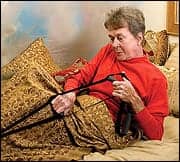 |
| A specially designed strap helps Pat Nelson get in and out of bed. |
When normal function is impeded by aging, formerly simple tasks in the home may become more difficult, such as climbing stairs, carrying packages in and out of the house, getting in and out of a bathtub safely, or just over reaching to take a vase down from a cabinet shelf. These challenges may happen very slowly due to arthritis and other degenerative conditions, or sometimes they can happen very suddenly, such as when a person has a bad fall, a stroke, or a knee replacement. It is only after coming home from the hospital or getting injured in a bathtub fall that people begin to look at how their home can be modified to help prevent future falls or environmental challenges.
Pynoos believes that Baby Boomers are at an ideal time in their lives to be thinking about home modification for the future. He says, “People who are Baby Boomers are often in the process of remodeling their homes. The first thing that they tend to do is remodel their kitchens or bathrooms, especially people who have lived in their house for a long time. This is a wonderful opportunity to make changes that will help them age in place and make life easier and more comfortable.”
CONSIDERING THE HOMEOWNER
When considering improving a home or designing a new home from the ground up, occupational therapists, architects, and interior designers must think about the space, but must also respect the individual.
“Most people see their homes as the place that they hold near and dear to their hearts,” says Nguyen, an occupational therapist and research scientist at The Fall Prevention Center of Excellence who specializes in home modification and fall assessments. The job requires a high level of awareness and sensitivity. She says, “As a therapist in general—physical, occupational, or any kind of therapist or health care professional—you make recommendations that, in your experience, can best help somebody. But for some individuals, asking them to install a grab bar may be a violation or a blow to their identity.”
Nguyen recommends that therapists collaborate with their clients to prioritize the hazards identified in the home and to discuss what the clients are most comfortable changing. She says, “In the end, it is the clients’ home and their lives, and any effect that we want to have on them—positive or negative—is based on what those clients are willing or not willing to do.”
THINKING AHEAD WITH UNIVERSAL DESIGN
To lessen the risk of costly retirement home remodifications after an accident or degenerative condition, Pynoos says that clients can work with architects and interior designers, and consult with therapists, about using Universal Design concepts.
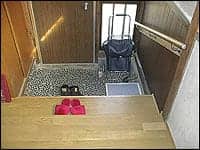 |
| Inside entrances should be well lit with sturdy railings. |
Universal Design is a term created by Ronald L. Mace, an architect and educator who died in 1998. In the Universal Design philosophy, it is the conventional home environment that creates the disability, not the person. Pynoos says, “Universal Design is a concept that basically says that housing should work for people of all ages, all sizes, and all abilities. The way this translates into housing in the most elemental manner is to think about places in the house that could present problems. So, the front steps could be difficult for anybody in a wheelchair, anybody who uses a walker, and in fact, for younger people who have children with strollers, or anybody trying to get a little roller-suitcase in and out of a house or carry packages.”
Aging individuals may also consider remodeling a two-story house so that—should the need occur—it would be possible to live entirely on the ground floor. For example, one can expand a den and then add or remodel an adjoining bathroom to include a universally designed walk-in shower with grab bars, an elevated toilet, and faucets with single-lever handles.
ASSESSING THE HOME
As a therapist specializing in fall prevention and home modification, Nguyen ideally likes to observe the patient performing common tasks. At the same time, Nguyen keeps five design goals in mind when assessing a home. Going through each room or outside the house, she considers:
Minimizing trip hazards. Remove items from walking surfaces to create clear areas by minimizing clutter; relocating phone wires, extension cords, and cables; or rearranging awkwardly placed furniture.
Maximizing slip resistance. Areas with slick surfaces (eg, tiles or a glossy floor) combined with water or other liquids (eg, bathroom, kitchen, or pool patio) can increase an individual’s risk of falling. Providing additional traction, such as by adding inexpensive adhesive nonslip strips or removing the item or liquid, can help reduce falls.
Minimizing overreaching. Relocate commonly used items to easily accessible areas. For example, in the kitchen, pullout drawers can be installed in lower cabinets to decrease bending and reaching. If items need to be retrieved from high places on occasion, using a wide-based step stool that has a hand rail that you can hold on to is an inexpensive solution.
Maximizing visual support. Proper lighting is especially important as we grow older and need more light. Aside from key lighting in task areas such as the kitchen, easy access to light switches and standing lamps are a plus for all ages and abilities. Backlit switches and night-lights can be an inexpensive but significant aid when waking up in the middle of the night to go to the bathroom.
Maximizing physical support. Physical support can come in many forms, depending on the room, from grab bars in the bathroom to hand rails on interior or exterior stairs, to specialized chair lifts that elevate patients from a seated to a standing position.
Other than the above parameters, Nguyen does not follow any one assessment scoring method, believing that every individual and home is unique. She further warns that only seeing the room can be misleading without observing the client engaged in the room’s routine activities, because falls are multifactorial in nature. Nguyen performed an assessment where she asked a client to step into the bathtub and the client used the doorknob to balance herself. While the client’s stepping into the tub may have had no issues, her reliance on an unstable door was a potential hazard. Similarly, a living room may actually be a bedroom for those who cannot reach a higher floor.
HOME MODIFICATIONS, FROM ELEVATORS TO THE “TOILEVATORS”
Home-modification solutions for fall hazards and preparing for the future will vary according to the environment and the client’s physical condition, budget, and taste. For Baby Boomers who are building or remodeling their retirement homes, it can be a big cost-saver to think ahead about certain common features.
For example, Pynoos tells of friends who are not only making their first floors potentially livable with universally designed dens and bathrooms, but who are also putting in elevators. Others who do not have the budget for an elevator have designed stacking closets, where the closets on the first floor are directly below the closets on the second floor. Then, if Pynoos’ friends ever require an elevator for second-floor access, the remodeling and cost would be substantially minimized.
Many Universal Design solutions are comparable in price to conventional designs, and they can be just as attractive, unobtrusive, and functional for all.
While Pynoos and Nguyen say that therapists must always consider a client’s individual wishes as well as the therapist’s recommendations, they do offer some general modifications and devices for each room or section of the house:
Bathrooms. Therapists generally assess how clients get in and out of the tub or shower and go to the restroom and perform personal care tasks at the sink.
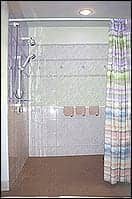 |
| An accessible shower sports curbless access for individuals in wheelchairs. |
No-step, curbless, tiled showers can now be nicely designed, allowing for a wheelchair or an assistive device to accompany the client.
Grab bars can now be decorative and attractively installed into tubs, showers, and by the toilet. In addition, pull-down grab bars, which can flip out of the way when not in use, are available. These can be installed on one or both sides of the toilet. There are also removable grab bars for the tub that can be hidden when company is present.
To decrease the risk of falls, therapists may recommend antislip strips be installed on the shower or tub. Also, bathroom rugs should have low piling with rubber backing. Floor tiles should be not be glazed or glossy.
Sink and tub fixtures can have a single-lever handle that mixes hot and cold water. Showers should also have adjustable handheld shower wands and antiscald devices installed.
Aside from removable shower chairs, contractors can now design built-in attractive tiled seats inside remodeled showers.
Toilets should be at 17 to 19 inches in height. As an alternative to removable raised toilet chairs or replacing a standard toilet, therapists can suggest “Toilevators,” which are modules that discreetly increase a standard toilet’s height by adding a matching raised base under the toilet’s original base.
As with all parts of the house, good lighting and flat light switches—possibly backlit—are user-friendly accessories for all abilities.
Kitchens. Occupational therapists should assess the way residents—especially home cooks—use the kitchen, reaching for pots and pans, as well as items in the refrigerator.
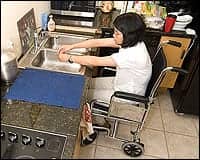 |
| A therapist can assess how a client negotiates the kitchen, and create cabinets, countertops, and work areas appropriate for their needs. |
Again, proper lighting is a must, especially around the stove, prep areas, and sink area.
As with bathrooms, single-lever faucets with hoses are convenient and offered in various appealing designs.
If remodeling the kitchen, create countertops at different levels for short people, tall people, or seated (wheelchair-level) people. Likewise, lower cabinets with pullout drawers will help everyone to cut down on bending and over reaching.
Spills from water, oils, or sauces are common, so unglazed tile floors will cut down the risk of falls.
Front-loading washers and dryers are efficient and accessible, decreasing over reaching strains.
Refrigerators with freezers on the bottom make the most common grocery items easy to reach.
Whether remodeling or not, rearrange everyday and frequently used items so that they are not stored too high or too low.
Bedrooms. Therapists typically assess how clients enter and exit the bed, where they sleep on the bed, and which way they walk to the bathroom.
|
To read more about best practices in creating accessible living spaces, go to AARP’s home design page. |
|
A lamp or light switch should be in easy reach.
Likewise, uncluttered nightstands are important so that clients will have important items such as glasses, a hearing aid, and a phone within easy reach.
It may be useful to remove rugs as a trip hazard, but try to accommodate clients who feel an attachment to items. Can a rug be hung on the wall?
Bedside floor-to-ceiling poles may be installed for support. There are also detachable bed grab bars that use the bed’s box spring and mattress as a counterweight. This can be removed when company is present.
Walkers, canes, or other assistive aids should be within reach, yet be out of the way when not in use.
There should be a clear, uncluttered path to the bathroom, perhaps lit by a night-light.
Also, for clients with mobility, weakness, or bariatric issues, there are many types of transfer devices, where caretakers use an overhead lift device to elevate and transfer patients in and out of wheelchairs to beds, bathtubs, or toilets.
Living Rooms. Orthopedic therapists should generally look at how the person uses the living room. Do they use it as a bedroom, or as an office with a little workstation set up on the coffee table or ottoman? Are these items and proper lighting easily accessible?
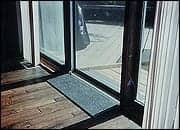 |
| A threshold ramp allows for easier transition for most individuals. |
To reduce trip hazards, attempt to reduce clutter, rugs, wires, and cords. If there is a wireless version of an appliance, such as a phone, try to suggest the client update to that model. The less wires the better.
If the environment is a sunken living room or den, ramps or chair glides can ameliorate the transition instead of a total remodel. If there are steps, install railings.
Chairs should be firmer and higher, rather than softer and low. Also, living room furniture should have armrests for added support.
For those who are weak in the legs or have strength and balance issues, automatic chairlifts are available, which can push the client up into a standing position.
Doors, floors, hallways, and stairs. Universal Design suggests wide doors, at least 34 inches for interior doors so that wheelchairs, scooters—perhaps a baby stroller—can have ample room to maneuver. Pocket doors, where the door slides into an interior wall, are also low-cost remodeling fixes. Swing-clear hinges can allow for more doorway room as well. Also:
Stairs can be a hazard and a challenge. Aside from lining steps with antislip strips, those incapable of climbing stairs can install a chair glide, a track-mounted seat attached to one side of the stairs.
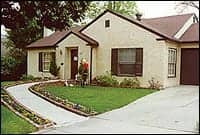 |
| More homeowners are modifying and making their houses more accessible, so individuals of any generation can age comfortably and safely in one place for years to come. |
Door handles with levers are easy to operate for everyone and come in a wide array of styles.
Hallways should have ample lighting with flat switches on opposite ends, perhaps backlit.
For added support and to aid balance, attractive wood-panel railings can be installed in hallways. Also, a new home’s hallways can be designed a few inches wider.
As much as possible and with collaborating with the client’s tastes, all floors should be free of clutter to reduce trip hazards. If possible, high-pile carpets should be replaced with low pile.
Threshold separating adjacent rooms should also be at or close to the same level. Lower-pile carpet that transitions into flooring is better than higher, softer piles.
Home entrances. Therapists should assess where the client enters as well as how. Does the person enter from the car to the garage? Through the front door or a side door? The path and the person’s physical constraints may dictate what modifications need to be made, if any.
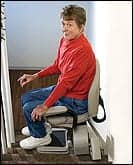 |
| Pat Nelson demonstrates how to use a chair glide, which can be installed to help a client negotiate stairs. |
If there are steps, railings on both sides may be needed, not just on one side.
If remodeling, a winding, slightly sloped, walkway may be an alternative to steps.
Permanent or portable ramps or wheelchair lifts or exterior chair glides may also be installed.
Garden hoses can be kept in a storage container or retractable caddy.
To decrease slips, walkways can be made from nonslip, coarse surfaces that can also be decorative, such as silica mixed with paint rather than glossy surfaces. Another low-cost solution are antiskid strips for steps.
Make sure there is plenty of lighting, perhaps using motion-detecting floodlights, lights on timers, or ones with low light sensors.
To make the entrance wheelchair/scooter accessible, design the doorways be 36 inches wide and have a flat threshold.
Levered door handles can be just as attractive (and more easy to use by all).
The suggestions listed here are just some of the ways that Baby Boomers and those approaching retirement can prepare their homes for their less active selves—or their less active friends and family.
Costs. It may be helpful for therapists and designers to stress how these simple changes can be no more expensive than a conventional remodel. Elevated toilets, better lighting, grab bars, and clearing clutter cost relatively little or nothing at all.
|
To read more about home modification, |
|
Therapists may also direct their clients or social workers to nonprofit and state programs that can help with grants for home modifications and purchasing fall-prevention equipment.
For more information and grant resources, go to the National Resource Center on Supportive Housing and Home Modification’s Web site at www.homemods.org, or the Fall Prevention Center of Excellence’s Web site at www.stopfalls.org.
Tor Valenza is a staff writer for Rehab Management. For more information, contact .





